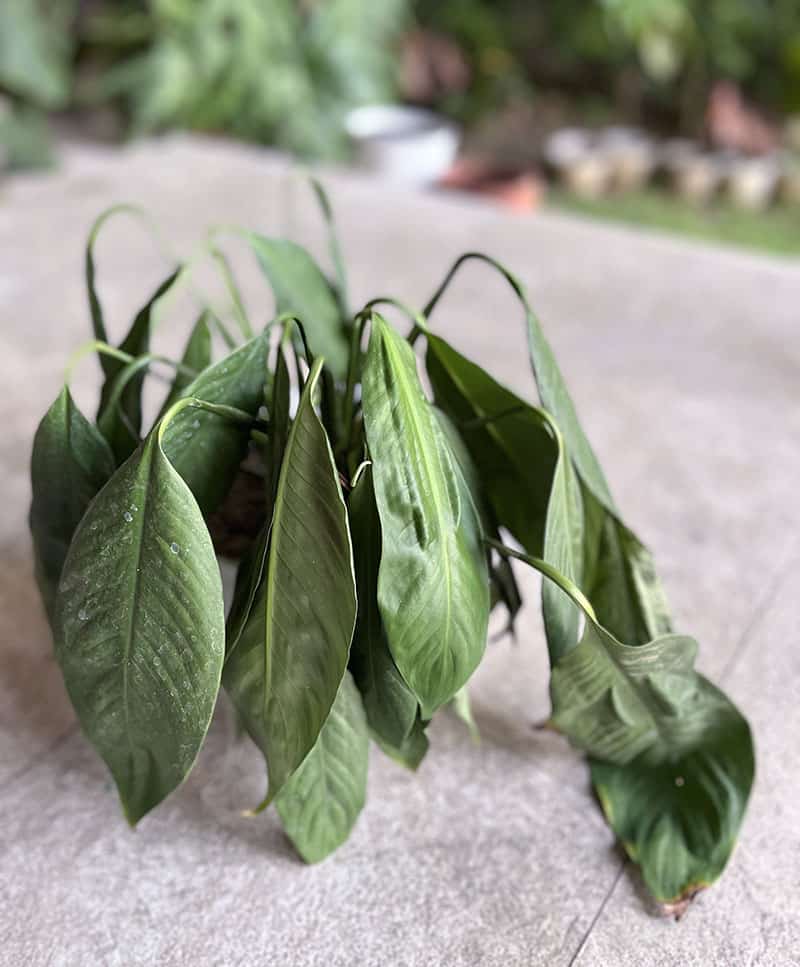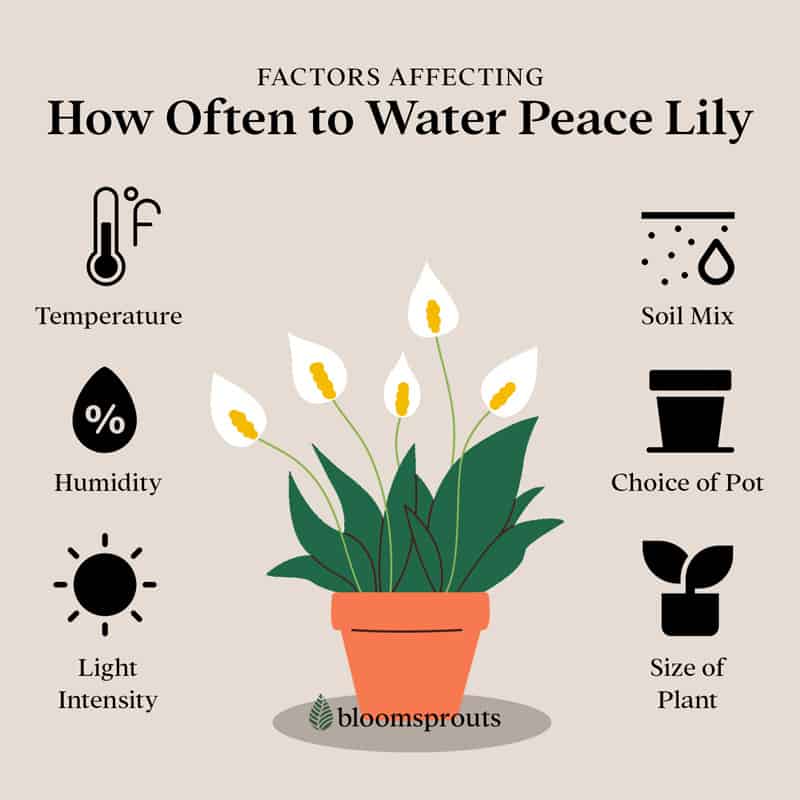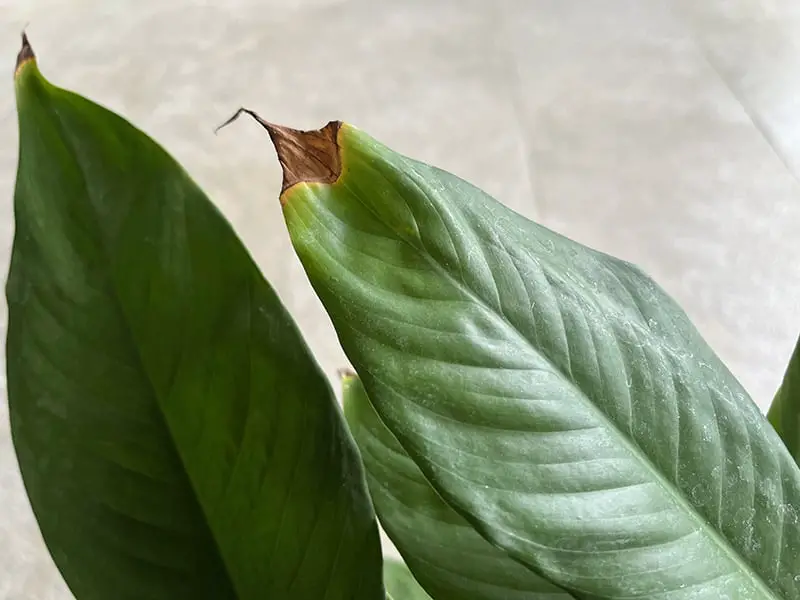
It is important to know how to water your Peace Lily properly to keep it healthy and thriving. Over-watering or under-watering your plant can lead to several problems, so it is important to know just the right amount to give it.
Generally, Peace Lily needs to be watered about once a week. However, several factors such as the size of the plant, the soil mix, the temperature, and the humidity can affect how often you need to water. Always check the soil before watering and water only when the top two inches of soil are dry.
In this guide, we will go over everything you need to know about watering your Peace Lily to keep it healthy and happy, including:
- Determining when to water your Peace Lily
- 9 Tips to water your Spathiphyllum
- Factors affecting how often to water
- Problems associated with the improper watering habit
Let’s get started!
When to Water Peace Lily
When I first started growing Peace Lily, I was watering it every day because I thought that’s what all plants need. However, I soon realized that too much water can be just as harmful as too little water.
There are things you should know that will help you determine when to water your Peace Lily, such as:
Avoid Watering On A Schedule
Although it’s important to water your peace lily regularly, you should avoid watering on a strict schedule.
This can actually do more harm than good because changes in the growing environment, temperature, and humidity can impact how often your plant needs to be watered.
Instead of watering on a set schedule, it’s best to check the soil moisture before watering.
How To Tell If Your Peace Lily Needs Watering
There are a few ways to tell if your peace lily needs watering.
The first way is to check the soil moisture with your fingers. Poke your finger about 2 inches into the soil.
If the soil feels dry, then it’s time to water. If the soil is still moist, then you can wait a few more days before watering again.
Another way to tell if your peace lily needs watering is using a soil moisture meter. This is a tool that you insert into the soil to measure the moisture content. If the meter shows that the soil is dry, then it’s time to water your plant.

Lastly, you can also look for obvious visual cues that your peace lily needs watering. For example, if the leaves start to droop or wilt, that’s a good sign that the plant is thirsty.
How Often to Water a Peace Lily in Winter
Unlike most houseplants, peace lily does not go dormant in winter.
However, the growth slows down and they stop producing blooms during this season because of reduced sunlight hours and intensity.
A cooler temperature also reduces moisture evaporation from soil and leaves.
Therefore, you should water the plant less often in winter than in summer to avoid over-watering.
A good rule of thumb is to water your peace lily once every two weeks in winter or when the top two inches of the soil feels dry.
Again, use your finger or a soil moisture meter to check the dampness before watering.
9 Practical Tips to Water a Peace Lily Plant
Now that you know how often to water your peace lily, let’s talk about the best ways to water it.
Here are a few tips:
1. Use Good Quality Water For Your Peace Lily
Tap water from the faucet usually contains chemicals like chlorine and fluoride, which can be harmful to your peace lily.
You can check the quality of your tap water using a water quality test kit, which is available at most hardware stores.
It’s best to use distilled water or rainwater if possible. If you can’t get either of those, then let the tap water sit for at least 24 hours before using it on your plant. This will allow the chemicals to evaporate.
2. Use Room-Temperature Water
It’s best to use room-temperature water because cold water can shock the plant and cause the leaves to droop.
If you don’t have room-temperature water, you can let the tap water sit for a few minutes to reach the ideal temperature.
3. Water The Soil, Not The Leaves
When watering your peace lily, be sure to focus on the soil and not the leaves. This is because the leaves are not as efficient in absorbing water as the roots.
In addition, wet leaves are more susceptible to fungal diseases. So, it’s best to keep them dry.
4. Use a watering can with a long spout
Using a watering can with a long spout helps you direct the water to the base of the plant without wetting the leaves.
5. Water generously
When watering your peace lily, be sure to give it a good drink. This means watering until the water comes out of the drainage holes at the bottom of the pot.
This ensures that the roots are getting enough water and also helps to flush out any built-up salts in the soil.
6. Ensure the water can drain out freely
It’s important to make sure that the water can drain out freely from the pot. Otherwise, the roots will sit in water, which can lead to root rot.
To ensure good drainage, use a pot with drainage holes and use a well-draining potting mix. You can also add some perlite, sand, or gravel to the potting mix to improve drainage.
Also read: Using Pots Without Drainage Holes: 5 Things You Should Know
7. Let The Soil Dry Out Between Watering
After watering your peace lily, be sure to let the soil dry out before watering again. This helps to prevent root rot and ensures that the plant is getting the oxygen it needs.
If you’re not sure if the soil is dry, you can use a finger or a soil moisture meter to check.
8. Add Water-soluble Plant Fertilizer regularly
Although Peace Lily isn’t a heavy feeder, adding a water-soluble plant fertilizer to the watering can help promote growth.
I recommend using a water-soluble plant fertilizer with an NPK ratio of 3-1-2 (fertilizers labeled with 24-8-16, 9-3-6, or 12-4-8 are also good).
You should fertilize your peace lily once a month during the growing season and every 8 weeks during the winter.
9. Using Self-watering pots
If you want to make watering your peace lily even easier, you can use a self-watering pot. These pots have a reservoir that stores water, which is then slowly released into the soil as needed.
This means that you don’t have to water your plant as often and you don’t have to worry about overwatering.
Factors Affecting How Often to Water a Peace Lily
In addition to the general watering tips above, there are a few other factors that can affect how often you need to water your peace lily.
These include:

Temperature
Plants use more water when they are at a higher temperature because photosynthesis occurs more rapidly. In addition, warm weather causes soil moisture to evaporate more quickly.
As a result, when you live in a hot climate, you need to water your peace lily more frequently than if you live in a cooler climate.
A friend of mine who lives in Singapore, where the temperature is almost always above 86 °F (30 °C), waters her peace lily every day and the plant is thriving!
Lighting
You should also consider how much light your plant receives when determining Peace Lily water requirements.
The photosynthesis of Peace Lilies is also accelerated in bright light, so they use more water.
If your peace lily is in a brightly lit spot, you may need to water it more frequently than if it is in a low-light area.
When living in low light conditions, watering too often can cause soil to become waterlogged, which can lead to root rot problems.
Nevertheless, excessive sunlight can also cause the leaves to scorch, which damages them and makes them brown. So, be sure to choose a spot that gets bright indirect light.
Humidity
Dry air around the plant will also cause the leaves to lose water more quickly, as moisture is released into the air through the process of transpiration.
If your home is particularly dry, you may need to water your peace lily more frequently than usual to replace the moisture that’s being lost.
Alternatively, a better solution may be to invest in a plant humidifier, which will help to raise the humidity levels around your plant to a more optimal level.
The Soil Mix
The type of potting mix you use can also affect how often you need to water your peace lily.
Some soil materials such as clay and peat moss absorb and hold water better than others. This means that you may need to water less frequently if you’re using a potting mix with these ingredients.
On the other hand, materials such as sand and perlite drain more quickly and don’t hold onto moisture as well. As a result, plants in these types of mixes often need to be watered more frequently.
That said, it’s important to note that dense potting mixes can lead to problems with drainage and waterlogging, so be sure to use a well-draining potting mix and choose a pot with drainage holes.
Choice Of Pot
The size and material of the pot you use can also play a role in how often you need to water your peace lily.
For example, terracotta pots are porous and allow water to evaporate through the sides of the pot, which means that plants in these pots often need to be watered more frequently.
Conversely, plastic pots are less porous and tend to retain moisture for longer periods of time. As a result, plants in plastic pots generally don’t need to be watered as often.
Larger pots also tend to hold on to reserve moisture for longer than smaller pots, so if you are using a large pot, you may be able to water your peace lily less often.
Size Of Peace Lily
The size of your peace lily will also affect how often you need to water it.
Generally, larger Peace Lily requires more frequent watering because they have larger leaves, which provide more surface area for photosynthesis and transpiration.
The bottom line is that you’ll need to experiment and use your best judgment to determine the ideal watering schedule for your peace lily. Start by watering your plant once a week and then increase or decrease the frequency as needed.
Peace lilies are forgiving plants and will usually bounce back if you forget to water them for a week or two. So, don’t worry if you’re not able to stick to a rigid watering schedule – your plant will probably be just fine!
Problems with Improper Watering
While peace lilies are relatively tolerant of inconsistent watering, there are a few problems that can arise if you don’t water them properly.
Under-watering
Peace lilies are forgiving plants and will usually bounce back if you forget to water them for a week or two. So, don’t worry if you’re not able to stick to a rigid watering schedule – your plant will probably be just fine!
However, if you consistently under-water your plant, it will eventually start to show signs of stress.
Signs of Dehydration in Peace Lily

The first sign of dehydration in Peace Lily is usually drooping, followed by browning or yellowing leaf tips. If the problem is not corrected for an extended time, the plant will eventually die.
Also read: How Long Can Plants Go Without Water?
Saving An Underwatered Peace Lily
If you notice that your peace lily is drooping, it’s a good idea to check the soil moisture level and water the plant as soon as possible.
Soak the soil thoroughly with lukewarm water and allow the excess water to drain out of the pot. Make sure to empty the drip tray after watering to prevent the roots from sitting in the water.
Once the plant has been watered, it should start to recover within a day or two.
Over-watering
While peace lilies are tolerant of inconsistent watering, they can be sensitive to overwatering.
If you water your plant too often or allow the roots to sit in water for extended periods, the plant is susceptible to root rot, which is a serious fungal disease.
Root rot can be difficult to treat and often leads to the death of the plant,
Signs of Over-watering in Peace Lily
The most common sign of over-watering of Spathiphyllum is yellow, limp, droopy leaves.
The rotten smell coming from the soil is another sign that the plant is getting too much water. If you notice this problem, it’s important to take action immediately as the root rot is probably already present and it will only get worse if the plant continues to be overwatered.
Saving An Overwatered Peace Lily
If you think your peace lily is getting too much water, the first thing you should do is inspect the roots.
If the roots appear brown, black, and mushy, it’s a sign that they are already rotting and the plant is in serious trouble.
In this case, you can try saving the plant by cutting away the affected roots and repotting the plant in a fresh, well-draining potting mix.
